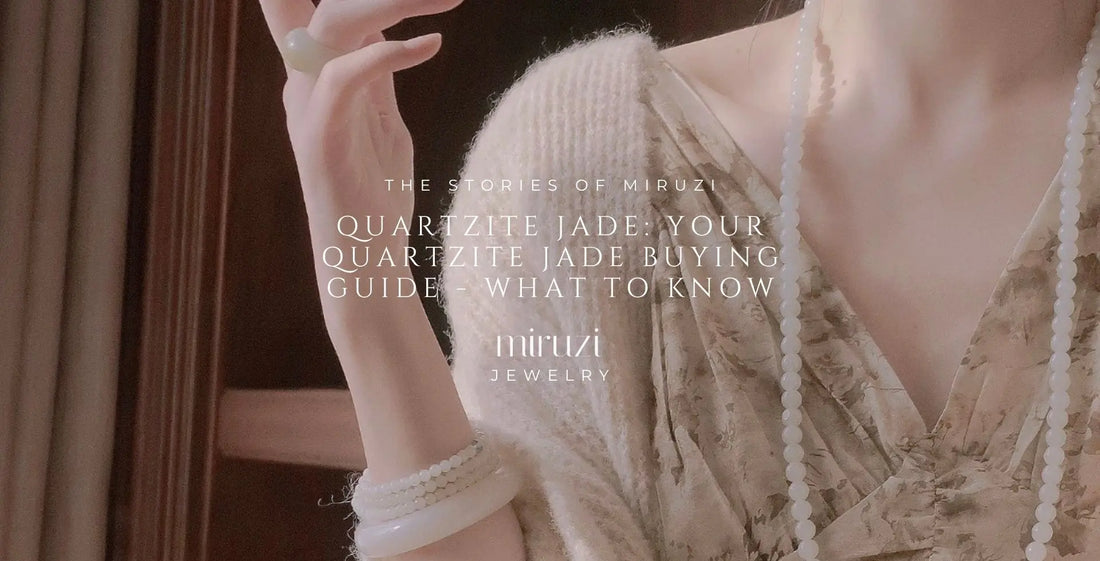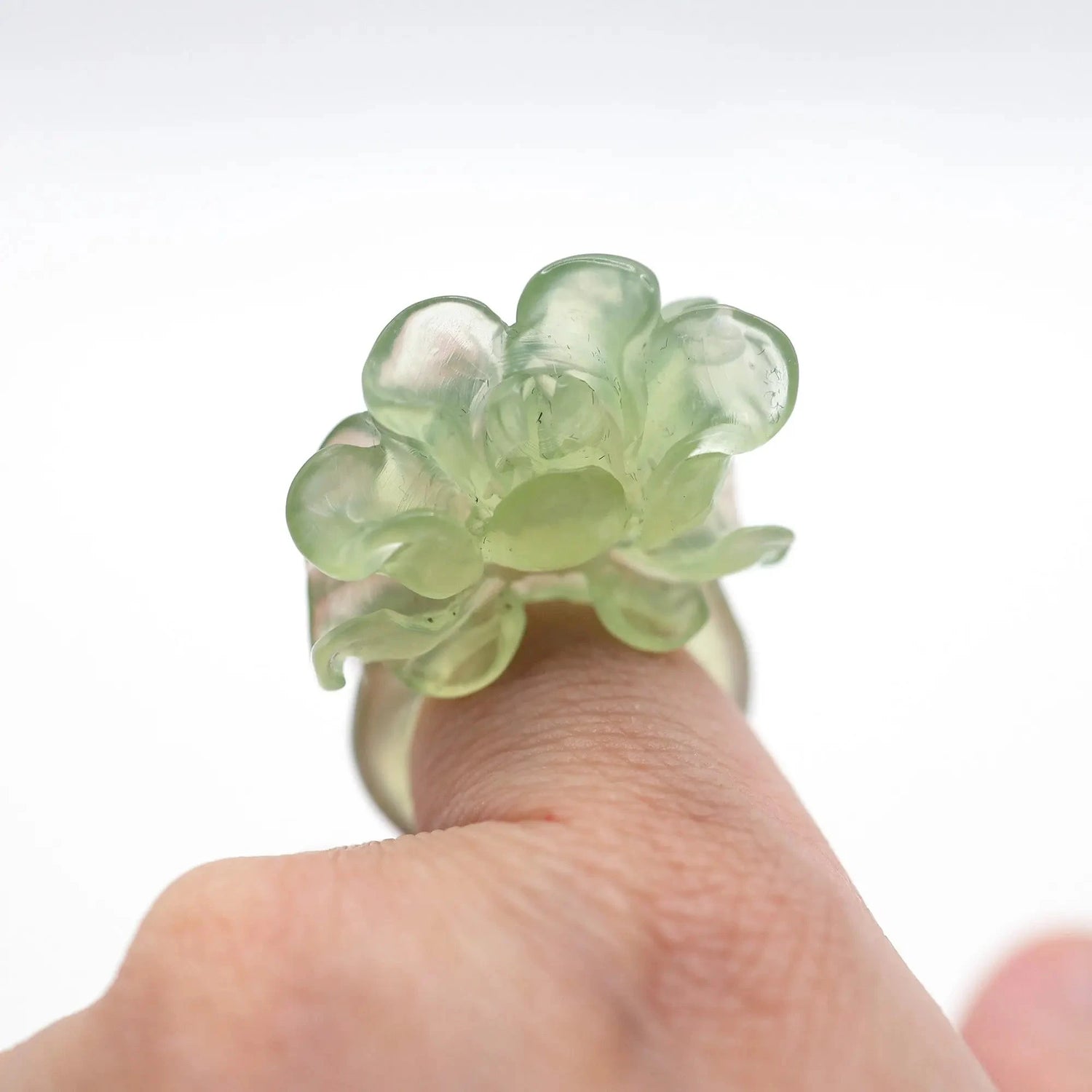
Quartzite Jade: Your Quartzite Jade Buying Guide - What to Know
Share
In the realm of gemstones and ornamental stones, Quartzite Jade stands apart—not just for its luminous beauty, but also for its strength, affordability, and cultural significance. Often mistaken for jadeite or nephrite, Quartzite Jade is an emerging favorite in both fashion jewelry and spiritual gemstone communities. But with growing interest comes the risk of confusion and misinformation.
This guide aims to equip you with the knowledge you need to buy Quartzite Jade with confidence—whether you’re selecting a bangle for everyday elegance or investing in a carved heirloom pendant. From identifying authenticity to understanding pricing, treatments, sourcing, and care, we’ll walk you through everything that matters before and after your purchase.
What Is Quartzite Jade? Clarifying the Basics
First, let’s clear up a common misconception: Quartzite Jade is not the same mineral as traditional jadeite or nephrite, although it's often visually similar. In gemological terms:
- Nephrite is a calcium magnesium silicate.
- Jadeite is a sodium aluminum silicate.
- Quartzite Jade, on the other hand, is a dense, fine-grained metamorphic rock composed primarily of interlocking quartz grains.

Thanks to this composition, Quartzite Jade exhibits a hardness of 7 on the Mohs scale, excellent polish, and vibrant color variations. It's valued not only for its durability and low maintenance but also for its broad availability and relatively affordable price compared to rare imperial jadeite.
Why Choose Quartzite Jade?
- Aesthetic Appeal: From soft white and lavender to deep green and crimson, Quartzite Jade offers a broader natural color range than nephrite or jadeite.
- Affordability: It’s significantly more accessible in price, making it ideal for younger buyers or collectors on a budget.
- Durability: Its hardness makes it suitable for daily wear—ideal for bangles, pendants, and rings.
- Spiritual Properties: Many associate it with calmness, grounding, and protection—similar to other jade types.
- Ethical Options: With more transparent supply chains, it's easier to trace and source Quartzite Jade responsibly.
Major Types and Varieties
Quartzite Jade is often named based on regional sourcing or appearance. Here are some notable varieties:
- Dongling Jade: Sparkling green due to chrome mica; sometimes sold as “green aventurine.”

➤ Explore our Floral Jade Bangle – Enchanted Green Mongolian Jade with Hand-Carved Flowers
- Jingbai Jade: Milky white with a creamy texture, highly polished.
- Golden Silk Jade (Jin Si Yu): Often red or yellow, featuring thread-like patterns—popular in northwest China.

➤ Explore our Petite Bracelet – Hand-Carved Floral Jade Bangle for Small Wrists
- Lavender Jade: Pale purple with calming undertones; highly sought for symbolic use.

➤ Explore our Elegant Purple Jade Bracelet – Hand-Carved Lotus & Plum Blossom Design | Mongolian Jade
- She Tai Cui: A green type from Inner Mongolia with unique floral carving appeal.
How to Identify Genuine Quartzite Jade
With so many lookalikes and synthetic imitations on the market, how can you tell if you're getting authentic Quartzite Jade?
1. Examine the Luster and Transparency
Real Quartzite Jade has a soft, waxy to glassy luster. Under light, it should appear subtly translucent, not glassy or plastic-like. Excessive shine can indicate resin coatings.
2. Check the Color Distribution
Natural stones have subtle color variations, including swirls, veining, or zoning. Dyed or glass imitations often have flat, overly uniform colors or abrupt transitions that look unnatural.
3. Feel the Temperature and Weight
Jade—whether jadeite, nephrite, or quartzite—feels cool to the touch and retains temperature longer than imitations. It should also feel slightly heavier than plastic or glass.
4. Perform the Scratch Test (Caution!)
On Mohs scale 7, Quartzite should not be scratched easily by steel or glass. However, perform this only on an inconspicuous area, as scratching fine jewelry is risky.
5. Ask for Certification
Reputable sellers provide gem identification reports from certified institutions (e.g., NGTC, GIA-equivalent local labs). These documents confirm the mineral composition and treatment status.
Treatments and Imitations to Watch For
Because of its similarity to jadeite, Quartzite Jade is often sold under misleading names or treated to appear more vibrant. Here’s what to look out for:
- Dyed Quartzite (C-Jade): May exhibit overly vivid greens or reds. Look for unnatural fluorescence under UV light.
- Resin-Impregnated (B-Jade): Treated for clarity and shine. Often shows a plasticky surface under magnification.
- Fused Glass/Plastic Imitations: Lighter weight, higher gloss, and no grain structure under magnification.
Tip: Ask your seller if the piece is “A-grade” (natural, untreated). “B” and “C” grades should be clearly disclosed.
Factors That Influence Price and Value
Just like traditional jade, the price of Quartzite Jade varies based on a number of aesthetic and technical factors:
1. Color
- Vivid greens and even whites are most prized.
- Lavender and red are rarer and carry spiritual meaning, increasing value.
2. Transparency
- The more translucent, the more desirable.
- Opaque stones are still beautiful, but less valuable.
3. Texture and Grain
- Finer, more compact grain structures feel smooth and polish better.
- Coarse or sandy textures lower the value and are harder to carve cleanly.
4. Craftsmanship
- Hand-carved or sculpted pieces carry a premium.
- Mass-produced items may cost less but lack uniqueness and detail.
Where to Buy Quartzite Jade
- Trusted Gem Shops and Jewelers: Look for specialists in East Asian gemstones or jade.
- Ethical E-commerce Brands: Look for brands offering transparency, certificates, and artisan collaborations.
- Gem Shows and Markets: Great for browsing, but verify authenticity with portable gem tools or on-site testing.
Red flag: Avoid “too good to be true” pricing on vivid jade colors. Natural Quartzite Jade is affordable but not cheap—especially for fine craftsmanship.
Caring for Your Quartzite Jade After Purchase
Once you've selected your perfect piece, preserving it is just as important. Quartzite Jade is tough but still deserves thoughtful care.
- Avoid chemicals: Remove jewelry before using perfumes, lotions, or household cleaners.
- Store separately: Keep in a soft cloth pouch or lined box to prevent scratches.
- Clean with care: Use warm water, mild soap, and a soft cloth. Avoid ultrasonic cleaning.
- Avoid extreme temperatures: Sudden heat or cold may cause cracks in carved or hollow pieces.
Why Quartzite Jade Is Worth the Investment
Quartzite Jade strikes a perfect balance between aesthetic charm, physical resilience, and accessible luxury. As more buyers move toward sustainable, meaningful purchases, this stone offers:
- Natural elegance without the markup of jadeite
- Ethical options in a transparent market
- A wide range of styles, from heritage to minimal
- Spiritual and emotional meaning rooted in centuries of jade reverence
Whether you're seeking a protective talisman, a fashionable everyday bangle, or a ceremonial gift, Quartzite Jade is a reliable, beautiful, and symbolic choice.

